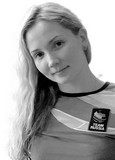The effect of upstroke on monofin swimming speed in young athletes in underwater sports
Keywords:
underwater swimmers, competitions, swimming technique, monofin, sports result, gliding, sports distance.Abstract
Objective of the study was to assess the impact of the upward movement on the swimming technique in a monolast and the rate of distance covered by athletes aged 12-13 who participate in underwater sports.
Methods and structure of the research. Submarine athletes aged 12 to 13 years (10 girls and 10 boys) took part in the scientific work. All athletes were conditionally divided into two groups of 10 people (5 girls and 5 boys): group A - athletes making equally powerful downward and upward strokes when swimming in a monofin, group B - athletes making only a powerful downward stroke. The following methods were used in the work: method of assessing time indicators, method of mathematical statistics.
Results and conclusions. Examining the swimming style and the time it takes for athletes to complete the distances, it is evident that the athletes in group A exhibit a superior performance and a more consistent technique compared to those in group B.
In conclusion, young swimmers aged 12 to 13 who participate in underwater sports are already competing at the national level as part of regional teams. Clearly, at this age, the swimming technique and time taken to complete the distances are of utmost importance.
Athletes who glide effortlessly across the water, using a monolast stroke, swim much faster. This is because their movement is smooth and effortless, allowing them to effortlessly glide across the surface of the water.
In contrast, swimmers who use a monolast stroke only downward bend their knees to lift the flipper, creating a submerged dive with their hands. This technique results in a pause between strokes, a lack of smoothness in the swimming motion, and a time performance that is significantly inferior.
References
Andreeva A.I., Andreeva S.K., Martynov A.I., Pavlov V.I. et al. Podvodnyy sport i zdorovye. Monograph. Moscow: DOSAAF SSSR publ., 1980. 222 p.
Moskovchenko O.N., Tolstopyatov I.A., Aleksandrov A.V. Podvodnyy sport i dayving. Study guide. Dictionary-reference book. 2nd ed., rev., sup. Krasnoyarskiy gosudarstvennyy pedagogicheskiy universitet im. V.P. Astafyeva. Krasnoyarsk, 2014. 316 p.
Available at: https://ru.m.wikipedia.org

Additional Files
Published
How to Cite
Issue
Section
License
Copyright (c) 2025 Theory and Practice of Physical Culture

This work is licensed under a Creative Commons Attribution 4.0 International License.
